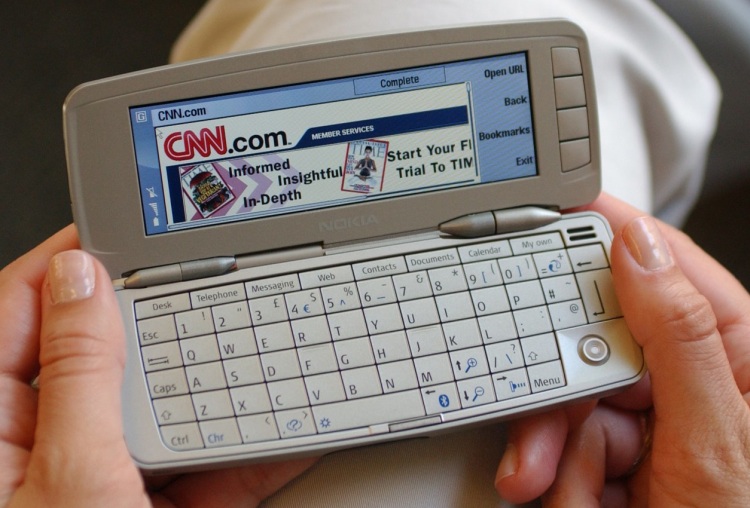Some interesting contenders: from left to right, the Nokia 9300i, the Nokia E90, the Nokia E75 and the Nokia N97...
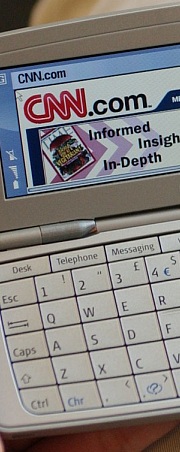
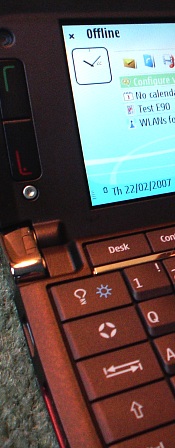
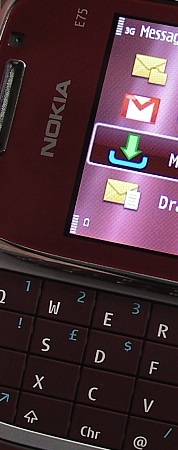
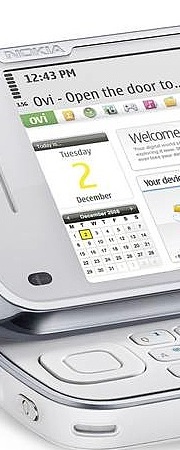
Let's see how the four devices, ranging from 2005 to 2009, stack up, spec by spec and feature by feature:
| Device | Nokia 9300i | Nokia E90 | Nokia E75 | Nokia N97 |
| Weight, dimensions, comments | 172g, 132x51x21mm | 210g, 132x57x20mm | 139g, 112x50x14mm | 150g, 117x55x17mm (19mm at points) |
| Screen/mechanism | Conventional hinges, which protrude when the 9300 is 'closed' | Double-jointed steel hinge, data through one hinge | Side-sliding (flat) only | Double-jointed alloy hinge with solid ribbon cable barrier |
| Display | 640x200 pixels (inner) plus 128x128 pixels (outer), both transflective TFT | 800x352 pixels (inner) plus 240x320 pixels (outer), transflective TFT | 320x240 pixels, both orientations, transflective TFT | 640x360 (nHD) transflective TFT, with resistive touch layer |
| Processor/RAM | 150MHz, 64MB for OS and apps (normally plenty). Not lightning fast but speed is rarely a problem | 330MHz, 80MB free. Quick device for many tasks and great at multitasking but held up by the large non-S60 standard screen size | 369MHz, 75MB free. Quick device for most tasks, but a couple of applications currently need optimisation (e.g. Calendar) | 434MHz/56MB free (without Facebook widget) after booting. Speedy for most tasks, you have to hit the N97 with large web pages and multiple widgets to hit the RAM limit and start slowing things down |
| Text input | Full five-row QWERTY keyboard, but key travel is small and joystick is fiddly. T9 input on the cover phone, but not full applications | Full five-row QWERTY keyboard, though keys are small. There's also T9-style text input on the outer 'cover phone' S60 interface | Four row QWERTY keyboard, largish keys but with flattish tops. Also physical T9-style keypad on the cover. | Three row QWERTY keyboard, somewhat condensed layout, space bar optimised for the right thumb and most punctuation on functioned keys or dedicated symbol grid. Also on-screen T9-style keypad entry. |
| Base OS | Symbian OS 7.0 | Symbian OS 9.2 | Symbian OS 9.3 | Symbian OS 9.4 |
| User interface | Series 80 (derived from the old Psion menu-driven system) on the inner communicator, proprietary common-actions interface on the cover phone | S60 3rd Edition, Feature Pack 1, providing a way to unify the cover and 'inner' phones, but at the expense of some usability and performance compromises. | S60 3rd Edition, Feature Pack 2, works well in portrait or landscape for all applications. D-pad and function keys can be awkward to press when the device is 'open'. | S60 5th Edition, largely tried and tested UI concepts, but with some distinct quirks for touch. Works well with d-pad and QWERTY keyboard, somewhat surprisingly, apart from the lack of a 'Ctrl' key and the resulting clumsy way copy and paste is implemented. |
| Firmware updates | Via Nokia Service centre only. Firmware was mature well before the 9300 was made 'end of life' | Via PC Suite, wipes C disk, so data re-syncing and app set up needed. Current firmware state = mature, but arguably incomplete. Nokia hasn't updated the firmware in ages. | Over the Air or via PC Suite/Updater. User Data Preservation. Current firmware state = very stable but with a few non-critical niggles. | Over The Air or via PC Suite/Updater. User Data Preservation. Current firmware state = buggy. |
| Application set highlights (built-in) | Full office editor (derived from old Psion Office suite) | Quickoffice (full editing, free upgrade to v6 Premium), Zip manager | Quickoffice (full editing, free upgrade to v6 Premium), Zip manager, Share online, Podcasting, Internet Radio, Dictionary, N-Gage. | Ovi Store, Share online, Podcasting, Quickoffice viewers (editing version available as a paid upgrade), Podcasting, Dictionary, Zip manager, Drawing, N-Gage game client, numerous Web 2.0 web site widgets, including Accuweather, Facebook, Qik, Boingo, YouTube |
| Web browser | Opera (circa 2005) | Webkit-based, Flash support | Webkit-based, Flash support | Webkit-based, Web next-gen, v7.1, with adequate Flash support |
| Navigation | via Bluetooth connection to GPS module and TomTom (or similar) software | GPS with Nokia Maps, full voice route guidance on subscription, GPS reception excellent | GPS with Nokia Maps, full voice route guidance on subscription, GPS reception good | GPS with Ovi Maps, with full voice route guidance on ad-hoc subscription model, GPS reception currently a little flawed, awaiting new firmware (etc.) Digital compass |
| Camera (stills) | None | 3 megapixels, LED flash, decent results in most light conditions | 3 megapixels, LED flash, good results in most light conditions (significantly better than E90) | 5 megapixels, Carl Zeiss optics, high quality, dual LED flash, superb results in average-to-good light conditions, camera glass scratch problems ruin LED flash photos though |
| Camera (video capture) | None | VGA capture, 30fps, focussed on a few metres, as per N95 | VGA capture, 30fps, focussed on infinity | VGA, 30fps, focussed on infinity, audio is very good |
| Audio | Mono loudspeaker, poor quality, stereo music via Pop-port headphones, but very limited software to play it (OggPlay was popular!) | Loud, high quality stereo speakers (though close together on rear!), excellent through headphones | Loudish, high quality mono speaker on rear, excellent through headphones | Stereo speakers, moderate volume, tinny/narrow frequency output, excellent through headphones |
| Video | Basic H.263 MP4 and 3GP videos supported | MP4 videos play well if specially crafted and optimised for the wide screen or if small enough to play in a box in the centre of the screen. Contains a hardware graphics acceleration chip | MP4/WMV videos play back acceptably, though frame rate and compatibility isn't 100% | MP4/WMV videos play back well, also BBC iPlayer compatible in the UK |
| Electrical | Nokia Pop-port data and audio, 3mm charging, 1100mAh battery | miniUSB (low speed) data, 2mm charging, 2.5mm audio jack, 1500mAh battery | microUSB (high speed) data and charging, plus 2mm charging, 3.5mm audio jack, 1000mAh battery | microUSB (high speed) data and charging, 3.5mm audio jack with TV out, 1500mAh battery |
| Network specs | Tri-band GSM | Quad band GSM, single band 3G | Quad band GSM, Tri band 3G | Quad band GSM, Tri band 3G |
| Wireless specs | Wi-Fi, Bluetooth, Infrared | Wi-Fi, Bluetooth, FM radio, infrared | Wi-Fi, Bluetooth, FM radio | Wi-Fi, Bluetooth, FM radio, FM Transmitter (surprisingly useful, for playing music and podcasts in the car) |
| Capacity (Gigabytes) | 80MB user flash memory, plus MMC expansion | 136MB internal flash memory, microSD expansion | 86MB internal flash memory, plus microSD expansion | 32GB internal mass memory, plus microSD expansion (under the battery cover) |
Of course, there's more to a comparison than simple specs can indicate. The Series 80 interface on the 9300 was popular with many for its (often) full-screen, pop-up menu operation, while the E90's adaptation of the designed-for-one-hand S60 interface proved just as unpopular with much the same crowd of users. It's fair to say that Series 80 and the 9300, and S60 and the E75, work especially well because they were designed for each other, while the E90's extended S60 and the N97's S60-plus-touch adaptations are often awkward. Which is at least party why there's a feeling afoot in the industry that S60 is a system stuck in 2005 to 2008, just as Series 80 was stuck in 2002 to 2005.
In terms of raw specifications, the progression from left to right in most areas is clear. You only have to compare the 9300 with the N97, which is smaller in most ways yet has vastly more features. It's very notable that features which require add-on software in year X often become part of the built-in package in year X+1.
Which of the four do I prefer? I've owned and liked all of them in different eras, but I think I'd have to pass on the E90 and 9300 - I've become too used to modern conveniences like:
- over-the-air firmware updates
- microUSB charging
- decent cameras
- 3.5mm audio jacks
- high speed USB
- the extra codecs and usability tweaks that came with S60 3rd Edition FP2 and beyond (e.g. WMV/H.264 support for video)
- quad band GSM and triband 3G
- smaller and lighter hardware
...to give them up!
Comments welcome on your take of the progression and development of the Communicator/QWERTY form factors dreamed up by Nokia's design teams!
Steve Litchfield, All About Symbian, 7 October 2009
